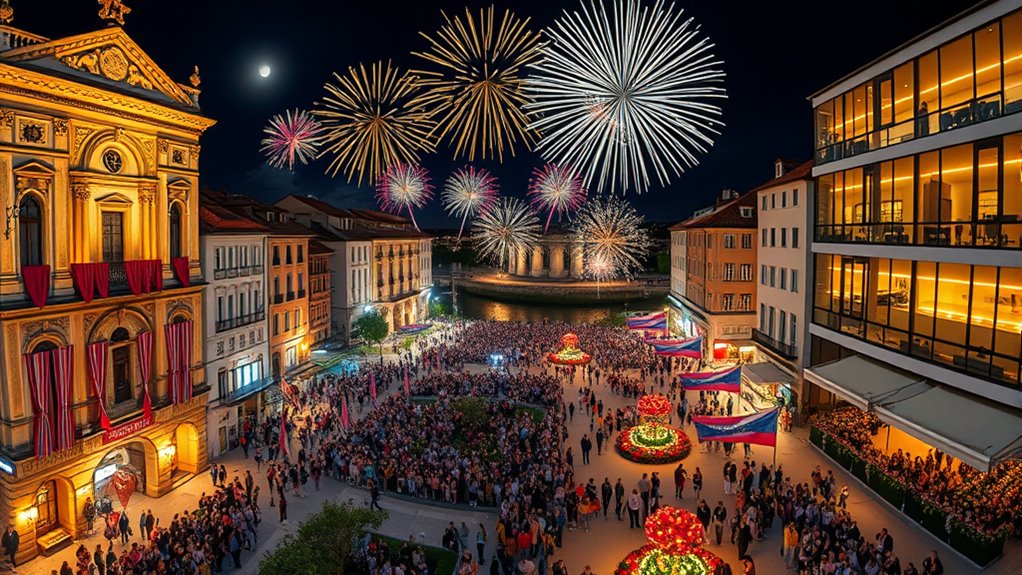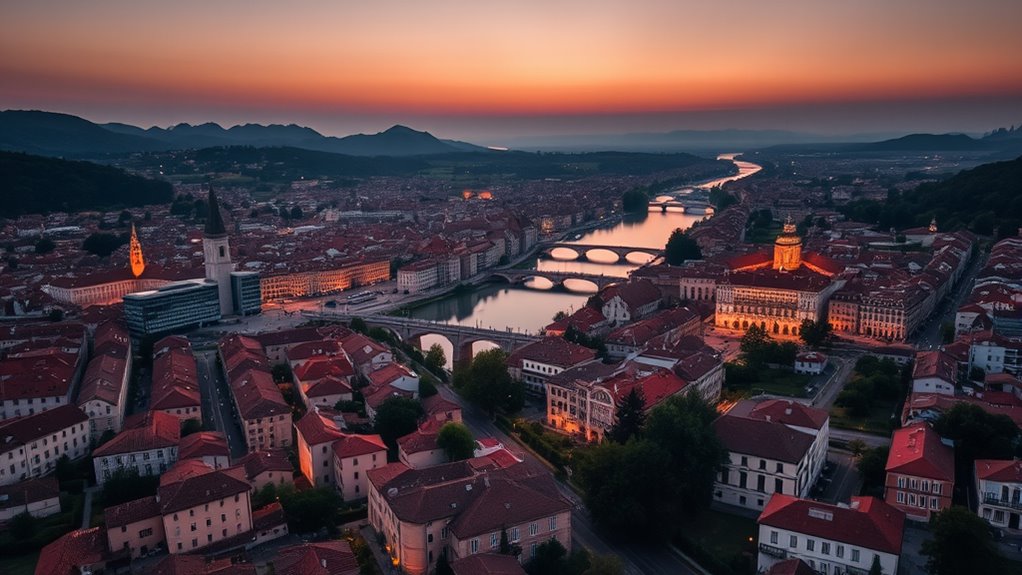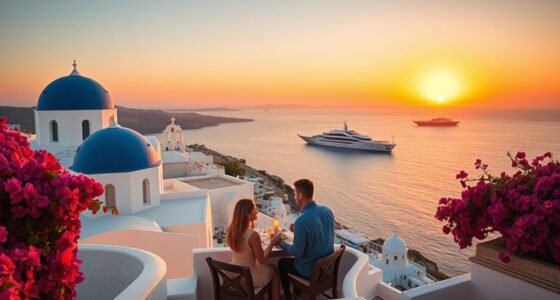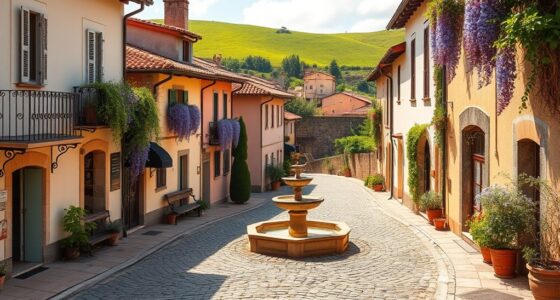In 2025, Gorizia and Nova Gorica come together as European Capital of Culture, transforming their shared history and border story into a lively cultural celebration. You’ll see how their contrasting architectures, natural landscapes, and vibrant community events reflect a journey of reconciliation and cooperation. From outdoor adventures to art exhibitions, the cities showcase their unique identities while fostering cross-border collaboration. Keep exploring to discover more about this inspiring fusion of tradition, innovation, and cultural unity.
Key Takeaways
- Gorizia and Nova Gorica jointly serve as European Capital of Culture 2025, fostering cross-border cultural exchange and regional integration.
- The event promotes shared heritage, innovative projects, and community participation through festivals, exhibitions, and performances.
- Urban contrasts reflect their historical and architectural identities, symbolizing cultural dialogue across the border.
- The celebration emphasizes outdoor heritage, natural landscapes, and outdoor activities that connect residents and visitors.
- Initiatives aim to transform borders into bridges, strengthening cooperation, sustainable development, and regional identity.
A Shared History Shaped by Borders

The history of Gorizia and Nova Gorica is deeply intertwined, yet their development has been shaped by shifting borders that divided and defined them. Border negotiations, like the 1949 Udine Agreement and the 1975 Osimo Treaty, regulated cross-border traffic and set territorial limits, often cutting off cultural sites and hindering cultural preservation. These negotiations reflected political changes that imposed physical barriers, isolating Gorizia from its hinterland and creating a distinct Nova Gorica on the Yugoslav side. Despite these divisions, shared geography fostered ongoing connections. Over time, political shifts, including Slovenia’s independence and EU integration, gradually loosened borders, enabling cooperation. Yet, the legacy of border negotiations continues to influence how the two cities preserve their unique cultural identities within a common historical framework. Additionally, the process of decentralization and cross-border collaboration is fostering new initiatives to reconnect and celebrate their shared heritage.
The Significance of the European Capital of Culture 2025

Gorizia and Nova Gorica’s joint designation as European Capital of Culture 2025 marks a historic milestone, as it’s the first time two cities from different countries share this honor. This initiative drives economic synergies and cultural diplomacy, transforming borders into bridges. Through a vibrant programme of events, exhibitions, and performances, you’ll witness a fusion of Italian and Slavic traditions fostering cultural unity. The collaboration also promotes peace and historical reflection, exemplified by projects like “A Walk of Peace” and the EPIC platform. These efforts turn shared history into a catalyst for reconciliation. The table below highlights key aspects of this cultural milestone:
| Aspect | Impact | Focus |
|---|---|---|
| Cross-border cooperation | Strengthens regional ties | Cultural diplomacy |
| Urban regeneration | Boosts local economies | Economic synergies |
| Artistic engagement | Inspires young artists | Cultural innovation |
| Historical memory | Promotes peace and reflection | Legacy of conflict |
| Tourism growth | Attracts international visitors | Sustainable development |
This collaborative effort also emphasizes the importance of color accuracy in creating a compelling cultural experience, as it enhances the visual impact of exhibitions and performances.
Architectural Contrasts and Urban Identity

As you explore Gorizia and Nova Gorica, you’ll notice stark differences between medieval and modern architectural styles that shape each city’s identity. Nova Gorica’s functionalist planning reflects socialist ideals, while Gorizia’s preserved heritage emphasizes its historic roots. These contrasting approaches highlight how urban planning philosophies influence not only cityscapes but also cultural perceptions and local pride. Incorporating architectural diversity in city development fosters a sense of inclusivity and historical continuity.
Medieval vs. Modern Styles
While Gorizia and Nova Gorica share a geographical border, their architectural styles vividly reflect contrasting historical eras and cultural identities. Gorizia’s medieval craftsmanship is evident in structures like the 11th-century Gorizia Castle and the Cathedral of Saint Hilary and Saint Tatius, showcasing stone masonry and historic urban layouts. In contrast, Nova Gorica’s modern urbanism is reflected in buildings like the Tito-era public architecture, the Solkan Bridge, and contemporary religious structures. This contrast can be summarized as:
- Use of historic stone and brick masonry versus concrete and modernist materials
- Compact medieval cityscape versus spacious, planned modern urban environment
- Preservation of medieval fortifications and courtyards versus modern engineering landmarks
- Cultural identity rooted in medieval craftsmanship versus modern architectural innovation
Additionally, the integration of natural materials in Nova Gorica’s newer constructions highlights a blend of progress and environmental consciousness.
Together, these styles define their unique urban identities, blending history with progress.
Urban Planning Philosophies
The urban planning philosophies of Gorizia and Nova Gorica reveal striking contrasts in how they shape their environments and express their identities. Nova Gorica’s post-war socialist approach prioritized urban renewal through modernist design, emphasizing green infrastructure, green corridors, and public spaces that foster community life. Its grid layout and planned districts contrast sharply with Gorizia’s organic, medieval fabric, which features dense streets and piazzas. Nova Gorica’s focus on slow mobility, pedestrian-friendly spaces, and reactivating border areas highlights a forward-looking philosophy rooted in social housing and public amenities. Meanwhile, Gorizia’s traditional spaces reflect centuries of European public space design, emphasizing social interaction and historical layering. The city’s design was heavily influenced by socialist urban planning principles, which aimed to create functional spaces for the working class. This approach also prioritized green infrastructure to promote environmental sustainability and improve residents’ quality of life. Together, these contrasting philosophies reveal how each city uses urban renewal and green infrastructure to shape its unique urban identity.
Architectural Heritage Significance
Architectural heritage reveals the deep-rooted identities that define Gorizia and Nova Gorica. You’ll notice Gorizia’s historic core, with religious heritage sites like the 14th-century cathedral rebuilt in Baroque style, and the Jewish quarter featuring an 18th-century synagogue. These landmarks highlight its multicultural past. Nova Gorica’s modernist architecture, influenced by socialist ideals, contrasts sharply with Gorizia’s historic fabric. Its public art and cultural venues, like the Slovene National Theatre, showcase contemporary design. The contrasts include:
- Historic stone buildings versus concrete blocks
- Baroque religious sites versus modernist structures
- Multicultural influences versus planned socialist aesthetics
- Preservation of religious heritage versus new public art installations
Additionally, the architectural contrasts contribute to a vibrant and layered urban identity, emphasizing the significance of architectural heritage in fostering cross-border cultural dialogue.
Embracing Natural Beauty and Outdoor Heritage

You can explore the stunning alpine and coastal landscapes that define Gorizia and Nova Gorica, offering breathtaking views and diverse outdoor experiences. Trails along the border ridge and around the Soča River invite you to enjoy hiking, biking, and other adventures immersed in nature. These natural settings highlight the region’s rich outdoor heritage and invite you to embrace its scenic beauty firsthand. Visiting landmarks such as Sabotin Hill and Vipava Valley further enhances your appreciation of the area’s natural beauty and outdoor activities. Supporting urban biodiversity initiatives can also help preserve these scenic environments for future generations.
Alpine and Coastal Landscapes
Nestled between rugged alpine peaks and gentle coastal influences, Gorizia and Nova Gorica showcase a striking blend of natural beauty and outdoor heritage. The landscape features the 609-meter Sabotin summit, offering panoramic views of mountain flora and valleys. You’ll discover caverns, WWI trenches, and diverse ecosystems thriving in alpine and sub-alpine habitats. The Karst Plateau’s limestone formations highlight alpine geology, while the Vipava Valley hills support rich biodiversity. The region’s geological features reveal a history shaped by complex natural processes that continue to influence the landscape today.
Outdoor Activities and Trails
Exploring the outdoor trails around Gorizia and Nova Gorica offers a perfect way to experience the region’s stunning natural beauty and rich heritage. The local trail networks are well-maintained and diverse, from easy family-friendly hikes to more challenging routes like Sabotin and Škabrijel, which provide panoramic views and historical insights. These trails emphasize nature conservation, supporting biodiversity and ecological awareness through informational signage and protected areas like Doberdò del Lago. Cross-border routes, such as the Goriški Camino, connect cultural landmarks and promote sustainable tourism. Unique outdoor heritage experiences, including smuggling tours and castle quests, blend adventure with history. Whether you’re seeking scenic serenity or active exploration, these trails showcase the region’s natural treasures while preserving its ecological integrity. Additionally, cultivating a creative practice during outdoor activities can deepen your connection to the environment and inspire new perspectives.
Cross-Border Collaboration and Community Life

How do Gorizia and Nova Gorica foster a sense of unity despite their national differences? They prioritize cross border dialogue and strengthen community resilience through active collaboration. Here are key ways they do this:
- Regular institutional meetings facilitated by frameworks like EGTCs promote ongoing cooperation.
- Events like the “Borderless Friendship March” reconnect residents, reviving shared traditions and symbolizing unity.
- Cultural exchanges and community activities, under the GO 2025 program, celebrate diversity and build social networks.
- Collaborative projects, including sustainable events and urban revitalization, attract visitors, boost local economies, and reinforce shared identities.
- Increasing interest in cross-border cooperation and the integration of shared infrastructure further enhance regional cohesion.
These efforts create a vibrant, resilient community that transcends borders, emphasizing cooperation and mutual understanding.
Cultural Institutions and Historical Memory

Cultural institutions in Gorizia and Nova Gorica actively preserve and interpret the region’s complex history through diverse programs and exhibitions. They serve as custodians of cultural memory, highlighting shared narratives of conflict, reconciliation, and hybridity. Exhibitions focus on regional figures like Zoran Mušič and explore contemporary textile and design art, bridging local traditions with modern perspectives. Artistic collaboration thrives, with institutions co-producing theatrical projects and supporting cross-border dance performances that reflect on borders and identity. Multimedia festivals and film screenings emphasize the region’s historical tensions and collective memory, while research centers document oral histories and testimonials. These efforts foster a nuanced understanding of the past, ensuring that both cities’ shared history remains alive through active engagement and innovative artistic responses. Incorporating cultural memory initiatives rooted in research and education further enriches the dialogue around regional history.
Events and Celebrations in the Twin Cities

The twin cities of Gorizia and Nova Gorica host a vibrant calendar of events and celebrations that promote cross-border unity and cultural exchange. These include:
- The Annual Borderless Friendship March in May, connecting the cities with routes of 7, 12, and 16 km, celebrating unity.
- A 10-day cultural, sports, and entertainment event around Europe Square, fostering community participation.
- The “Tastes without Borders” festival in late September, blending local culinary traditions and cultural fusion.
- Public art initiatives, such as exhibitions and collaborative installations, highlight shared history and borderless creativity.
- Throughout the year, these events showcase a rich mix of local traditions and innovative public art, strengthening social bonds and cross-cultural understanding across the border.
- Promoting cross-border collaboration through these initiatives encourages sustainable development and regional integration.
Looking Ahead: The Future of Gorizia and Nova Gorica

Looking ahead, Gorizia and Nova Gorica are poised to strengthen their bond through innovative infrastructure projects and shared cultural initiatives. Sustainable transportation will play a key role, exemplified by the new cross-border bus service launching in spring 2025, which boosts daily connectivity and reduces physical and symbolic divides. This initiative, supported by the Friuli Venezia Giulia region, aims to foster social and economic integration, moving beyond historic border concepts. Additionally, digital connectivity will enhance collaboration, enabling seamless communication and joint urban development. The cities’ status as European Capital of Culture 2025 under the “GO Borderless” theme underscores their commitment to cultural integration and shared heritage. These efforts will solidify Gorizia and Nova Gorica as models of cross-border cooperation, innovation, and sustainability for the future.
Frequently Asked Questions
How Do Residents Perceive the Ongoing Cultural Integration Between Gorizia and Nova Gorica?
You see the ongoing cultural integration shaping your local identity, fostering a sense of unity between communities. While many embrace cultural acceptance through shared projects like festivals and culinary events, some remain cautious due to lingering tensions and economic disparities. You notice that residents generally view these efforts positively, but challenges like language barriers and unequal participation still influence perceptions. Overall, the integration is seen as a step toward a more inclusive, cross-border European community.
What Specific Projects Are Planned to Showcase Cross-Border Collaboration During 2025?
Imagine a bridge where art and culture intertwine—this is what your city plans for 2025. You’ll see cross-border art projects and joint exhibitions that highlight shared heritage and creativity. Specific initiatives include collaborative art installations, cultural exchange programs, and co-curated exhibitions. These projects celebrate unity and diversity, transforming borders into bridges, and offering you a vibrant, immersive experience of collaboration between communities.
How Has Tourism Evolved Since the Border Restrictions Were Eased in 2007?
Since the border reopening in 2007, you’ve seen significant tourism growth in the region. The removal of restrictions boosted cross-border travel, encouraging cultural exchanges, joint events, and shared attractions. You’ll notice more hotel beds, increased visitor numbers, and a vibrant creative scene. This development has strengthened the local economy and fostered a seamless, borderless community, making the area a dynamic destination for both cultural and nature-based tourism.
In What Ways Are Local Traditions Preserved Amidst Architectural and Cultural Changes?
You can see local traditions preserved through active efforts like supporting local craft preservation and celebrating traditional festivals. These initiatives keep cultural identity alive amid architectural and cultural changes. By participating in traditional festivals, you help sustain regional heritage, and through promoting local crafts, you contribute to the community’s cultural continuity. This ongoing dedication guarantees that history and customs remain vibrant, even as the city evolves architecturally and culturally.
What Impact Will the European Capital of Culture Designation Have on Regional Infrastructure?
The European Capital of Culture designation will boost regional infrastructure through urban renewal and transportation upgrades. You’ll see improved public transit, better roads, and modernized cultural venues, making it easier to access events and attractions. These enhancements encourage tourism, foster community engagement, and promote sustainable development. Ultimately, the designation helps create a more connected, vibrant region that celebrates its cultural heritage while embracing innovative infrastructure improvements.
Conclusion
As you explore Gorizia and Nova Gorica, it’s clear these cities are more than just borders—they’re a shared story of resilience and unity. With 2025’s European Capital of Culture spotlight, you’ll witness their vibrant spirit and evolving identity firsthand. Will you embrace the chance to experience this unique cross-border collaboration and celebrate their rich heritage? These twin cities invite you to be part of their inspiring journey toward a brighter, connected future.









